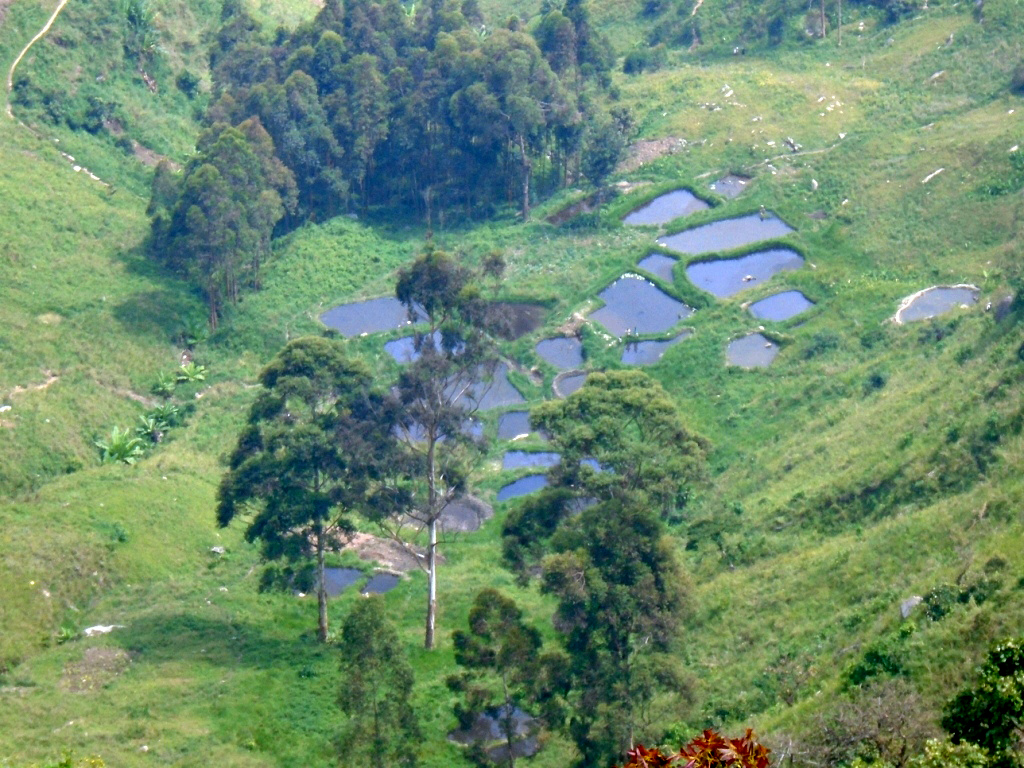Development Activities in the Vicinity of Mount Tshiaberimu
Categories: Journal no. 52, Protective Measures, Democratic Republic of the Congo, Mt. Tshiaberimu, Grauer's Gorilla, Gorilla Journal, Success Stories
Located close to Virunga National Park, the Sarambwe Reserve and Mount Tshiaberimu are two threatened sites where gorillas still occur. As ecotourism is not yet practical here, these two sites receive only minimal support from the national authority in charge of conservation and tourism. The situation is exacerbated by the remoteness of the sites from the main road and by the insecurity created every now and then by outlaws and armed groups. At Sarambwe, for instance, the park rangers are often recalled to park headquarters due to insecurity - as is the case at the time of writing. At these times, the monitoring of the reserve is under the sole responsibility of the trackers supported by Berggorilla & Regenwald Direkthilfe.
Activities at these two sites are often supported by partner organisations whose agendas include gorilla conservation. Without their support, the survival of the gorillas at these sites seems highly unlikely as the national authority in charge of conservation is not adapting its strategy for these sites, in spite of the special circumstances. The Gorilla Organization, which used to work at Mount Tshiaberimu with Berggorilla & Regenwald Direkthilfe (B&RD), has recently pulled out. The International Gorilla Conservation Programme (IGCP) is also no longer active in Sarambwe or Mikeno. Only B&RD is still active in the Sarambwe Reserve and on Mount Tshiaberimu. The development measures carried out in the vicinity of Mt. Tshiaberimu are described below.
Ongoing Activities near Mount Tshiaberimu
At the moment, only one project is being implemented in the vicinity of Mount Tshiaberimu. This is a fish-farming project, where fish are raised in ponds. The objective of the project is as follows: Lake Edward is an integrated part of the Virunga National Park. Its shores follow the base of Mt. Tshiaberimu. We should remember that the population on Mt. Tshiaberimu lives on agriculture and the raising of poultry (chicken and ducks), but is little developed. Rabbits are also raised, but fish farming is still in its infancy. Frequently, there are signs that animals are being poached in the forest on Mount Tshiaberimu. Mostly using traps, the poachers target terrestrial mammals such as duikers, giant forest hogs and Gambia giant rats. However, gorillas are frequently caught in these traps.
The development of fish-farming will help to reduce the level of poaching and will be a source of income and animal protein, which is currently lacking. It will also sensitize the population concerning the conservation of gorillas and other animals in the park.
The project has the following objectives:
- train the population in fish-farming using ponds;
- teach the population how to build or adapt a pond and how to maintain it to guarantee a good yield;
- instruct the population in the natural history of Tilapia, its life cycle, growth, food requirements, and the capture and transport of fry;
- build or adapt six pilot ponds, stock them with fry and monitor their growth until they are ready for harvest;
- monitor activities for a duration of at least 6 months and at the end of this time facilitate the harvest and distribution of fry.
In July 2015, the first training was carried out in Vurusi: fifteen fish-farmers were trained from four sites (Vurusi, Kitevya, Vulambo and Kasimbi) selected for the development of fish farms. Two pilot fish ponds were selected for development for each of the latter three sites. Training was delivered before the ponds were developed in the three pilot sites.
The six ponds were created between September and November 2015; they were stocked with fry and the fish grew well and fast. A first trial capture of fry from two ponds is planned for June 2016; the fish should be ready for harvesting in September 2016.
A campaign to sensitize the population on the potential for fish farming took place in September 2015. Another campaign was carried out in January 2016. As a result, many people have been attracted to the project. Although initially only 6 fish ponds and about 15 family ponds had been planned, the population mobilized itself to construct more (at the beginning of May, they had constructed 59 family ponds). They were advised to construct diversion ponds in order to make use of the hill streams. The population worked together to dig ponds: about 10 people joined together to dig a pond for one of the group; once that was done they moved on to dig a pond for another group member, and so on until every member of the group had their own pond. Aside from the funds used for the 6 pilot ponds, the groups were supported with materials for digging and pond construction.
The current situation is as follows:
- Kitevya: There are two pilot ponds and 37 family ponds, 13 of which were dug before the end of December 2015; 24 were constructed between January and the beginning of April 2016. Twenty ponds are diversion ponds.
- Kasimbi: The youth of this region has the target of establishing 40 ponds. A fish-farming group consisting of 10 people are mobilised to sensitise others. They had nine ponds, but unfortunately, three ponds were destroyed by landslides. Six ponds remain including two pilot ponds.
- Vulambo has 15 ponds including two pilot ponds. A large community pond was being developed, but the work has stopped due to a land dispute. Even so, 15 ponds are currently being stocked with fry.
- Vurusi: Five ponds have already been constructed and stocked with fry.
After September 2016, the fish-farming activities will be sustainable as they are cost-effective. The fish-farming groups have united and agreed on fixed prices: one fry costs 100 Congolese Francs (equivalent to 0.1 US dollar), one medium fish sells for 500 Congolese Francs and a 1 kg fish sells for 1,000 Congolese Francs.
Claude Sikubwabo Kiyengo

